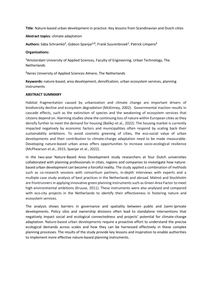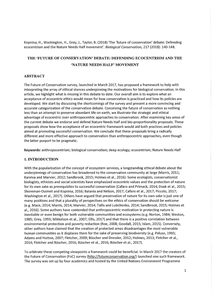This chapter is about the development of tourism in the Dutch Wadden Sea Region in combination with nature conservation. The main question is whether they have a common future. There are some future points stated:- Nature and landscape of the Wadden Sea are the main pull factors for the tourism development. - Future tourism development requires a clear strategy that is supported by various stakeholders- Raising awareness about the natural values results in more visitors and public support for nature conservation- The World Heritage status facilitates cooperation between local entrepreneurs and nature conservation organisationsOverall the conclusion can be drawn that, stimulated by the World Heritage status of the Wadden Sea and facilitated by a trilateral Sustainable Tourism Strategy, tourism development and nature conservation and can mutually benefit. Raising awareness about the natural values of the Wadden Sea will result in more visitors to the region and contributes to an emotional attachment to the protected area and public support for the conservation programs.
DOCUMENT

Biodiversity, including entire habitats and ecosystems, is recognized to be of great social and economic value. Conserving biodiversity has therefore become a task of international NGO’s as well as grass-roots organisations. The ‘classical’ model of conservation has been characterised by creation of designated nature areas to allow biodiversity to recover from the effects of human activities. Typically, such areas prohibit entry other than through commercial ecotourism or necessary monitoring activities, but also often involve commodification nature. This classical conservation model has been criticized for limiting valuation of nature to its commercial worth and for being insensitive to local communities. Simultaneously, ‘new conservation’ approaches have emerged. Propagating openness of conservation approaches, ‘new conservation’ has counteracted the calls for strict measures of biodiversity protection as the only means of protecting biodiversity. In turn, the ’new conservation’ was criticised for being inadequate in protecting those species that are not instrumental for human welfare. The aim of this article is to inquire whether sustainable future for non-humans can be achieved based on commodification of nature and/or upon open approaches to conservation. It is argued that while economic development does not necessarily lead to greater environmental protection, strict regulation combined with economic interests can be effective. Thus, economic approaches by mainstream conservation institutions cannot be easily dismissed. However, ‘new conservation’ can also be useful in opening up alternatives, such as care-based and spiritual approaches to valuation of nature. Complementary to market-based approaches to conservation, alternative ontologies of the human development as empathic beings embedded in intimate ethical relations with non-humans are proposed. https://www.linkedin.com/in/helenkopnina/
DOCUMENT

Social scientists of conservation typically address sources of legitimacy of conservation policies in relation to local communities’ or indigenous land rights, highlighting social inequality and environmental injustice. This chapter reflects on the underlying ethics of environmental justice in order to differentiate between various motivations of conservation and its critique. Conservation is discussed against the backdrop of two main ethical standpoints: preservation of natural resources for human use, and protection of nature for its own sake. These motivations will be examined highlighting mainstream conservation and alternative deep ecology environmentalism. Based on this examination, this chapter untangles concerns with social and ecological justice in order to determine how environmental and human values overlap, conflict, and where the opportunity for reconciliation lies, building bridges between supporters of social justice and conservation. https://www.springer.com/gp/book/9783319713113#aboutBook LinkedIn: https://www.linkedin.com/in/helenkopnina/
MULTIFILE

We address the explicit ecocentric roots of conservation science and the support of a growing number of conservationists for ecocentric natural value. Although ecosystem‐services arguments may play an important role in stemming the biodiversity crisis, a true transformation of humanity's relationship with nature ought to be based in part on ecocentric valuation. Conservation scientists have played a leading role in initiating this transformation, and they ought to continue to do so. https://doi.org/10.1111/cobi.13067 LinkedIn: https://www.linkedin.com/in/helenkopnina/
MULTIFILE

Justice for nature remains a confused term. In recent decades justice has predominantly been limited to humanity, with a strong focus on social justice, and its spin-off – environmental justice for people. We first examine the formal rationale for ecocentrism and ecological ethics, as this underpins attitudes towards justice for nature, and show how justice for nature has been affected by concerns about dualisms and by strong anthro-pocentric bias. We next consider the traditional meaning of social justice, alongside the recent move by some scholars to push justice for nature into social justice, effectively weakening any move to place ecojustice centre-stage. This, we argue, is both unethical and doomed to failure as a strategy to protect life on Earth. The dominant meaning of ‘environmental justice’ – in essence, justice for humans in regard to environmental issues – is also explored. We next discuss what ecological justice (ecojustice) is, and how academia has ignored it for many decades. The charge of ecojustice being ‘antihuman’ is refuted. We argue that distributive justice can also apply to nature, including an ethic of bio-proportionality, and also consider how to reconcile social justice and eco-justice, arguing that ecojustice must now be foregrounded to ensure effective conservation. After suggesting a ‘Framework for implementing ecojustice’ for conservation practitioners, we conclude by urging academia to foreground ecojustice. https://doi.org/10.1016/j.biocon.2018.09.011 LinkedIn: https://www.linkedin.com/in/helenkopnina/
MULTIFILE

Abstract from AMS Scientific Conference '24, Amsterdam, Netherlands.In the two-year Nature-Based Area Development study researchers at four Dutch universities collaborated with planning professionals in cities, regions and companies to investigate how nature-based urban development can become a forceful reality. The study applied a combination of methods such as co-research sessions with consortium partners, in-depth interviews with experts and a multiple case study analysis of best practices in the Netherlands and abroad.Keywords: nature-based, area development, densification, urban ecosystem services, planning instruments
DOCUMENT

Transboundary conservation has an important, yet often undervalued, role in the international conservation regime. When applied to the legally ambiguous and interconnected marine environment this is magnified. The lack of clear guidance for transboundary marine conservation from the international conservation community exacerbates this problem, leaving individual initiatives to develop their own governance arrangements. Yet, well-managed transboundary marine protected areas (MPAs) have the potential to contribute significantly to global conservation aims. Conversely, in a period where there is increasing interest in marine resources and space from all sectors, the designation of MPAs can create or amplify a regional conflict. In some instances, states have used MPAs to extend rights over disputed marine resources, restrict the freedom of others and establish sovereignty over maritime space. Six case studies were taken from Europe, North Africa and the Middle East to illustrate how states have interpreted and utilized different legislative mechanisms to either come together or diverge over the governance of marine resources or maritime space. Each of the case studies illustrates how different actors have used the same legislative tools, but with different interpretations and applications, to justify their claims. It is clear that the role of science combined with a deeper engagement with stakeholders can play a critical role in tempering conflict between states. Where states are willing to cooperate, the absence of clear guidelines at the global level means that often ad hoc measures are put into place, with the international frameworks then playing catch up. Balancing different jurisdictional claims with the conservation of the marine environment, whilst considering the increasing special economic interests will become increasingly difficult. Developing a transboundary conservation tool, such as the simple conservation caveats found in the Barcelona Convention and Antarctic Convention, which allow for the establishment of intergovernmental cooperation without prejudicing any outstanding jurisdictional issue, would provide a framework for the development of individual transboundary MPAs.
DOCUMENT

The Future of Conservation survey, launched in March 2017, has proposed a framework to help with interpreting the array of ethical stances underpinning the motivations for biological conservation. In this article we highlight what is missing in this debate to date. Our overall aim is to explore what an acceptance of ecocentric ethics would mean for how conservation is practised and how its policies are developed. We start by discussing the shortcomings of the survey and present a more convincing and accurate categorization of the conservation debate. Conceiving the future of conservation as nothing less than an attempt to preserve abundant life on earth, we illustrate the strategic and ethical advantage of ecocentric over anthropocentric approaches to conservation. After examining key areas of the current debate we endorse and defend the Nature Needs Half and bio-proportionality proposals. These proposals show how the acceptance of an ecocentric framework would aid both practices and policies aimed at promoting successful conservation. We conclude that these proposals bring a radically different and more effective approach to conservation than anthropocentric approaches, even though the latter purport to be pragmatic. https://doi.org/10.1016/j.biocon.2017.10.016 https://www.linkedin.com/in/helenkopnina/
MULTIFILE

As many in society work towards global sustainability, we live at a time when efforts to conserve biodiversity and geodiversity, and combat climate change, take place simultaneously with land grabs by large corporations, food insecurity, and human displacement through an ecological breakdown. Many of us seek to reconcile more-than-human nature and human nature and to balance intrinsic value and the current human expansion phase. These and other challenges will fundamentally alter the way people, depending on their worldview and ethics, relate to communities and the environment. While environmental problems cannot be seen as purely ecological because they always involve people, who bring to the environmental table their different assumptions about nature and culture, so are social problems connected to environmental constraints. Similarly, social problems are fundamentally connected to environmental constraints and ecological health. While nonhumans cannot bring anything to this negotiating table, the distinct perspective of this book is that there is a need to consider the role of nonhumans as equally important stakeholders – albeit without a voice. This book develops an argument that human-environmental relationships are set within ecological reality and ecological ethics. Rather than being mutually constitutive processes, humans have obligate dependence on nature, not vice versa. We argue that over-arching ecological ethics is necessary to underpin conservation in the long-term. This requires a holistic ‘justice’, where both social justice (for humans) and ecological justice (for nature) are entwined. However, given the escalating environmental crisis and major extinction event we face, and given that social justice has been dominant for centuries, we believe that in many cases ecojustice will need to be prioritized. This will depend on the situation, but we feel that under ecological ethics, holistic ethics cannot always allow social justice to dominate, hence there is an urgent need to prioritize ecojustice today. Accordingly, this book will deal with questions of both social and ecological justice, putting forth the idea that justice for both humans and nonhumans and their habitats can only be achieved simultaneously. This book will explore the following questions: What is the relationship between social and ecological justice? How might we integrate social and ecological justice? What are the major barriers to achieving this simultaneous justice? How can these barriers be overcome? What are the major debates in conservation relevant to this? doi: 10.1007/978-3-030-13905-6 LinkedIn: https://www.linkedin.com/in/helenkopnina/
MULTIFILE

With this paper, it is illustrated that a focus on entrepreneurship training in the nature and wilderness sector is relevant for diverse organisations and situations. The first curricula on nature entrepreneurship are currently being developed. In this paper the authors describe a project that focusses on educating the next generation of nature entrepreneurs, reflect on the Erasmus Intensive Program ‘European Wilderness Entrepreneur’ and the Wild10 World Café on nature entrepreneurship training. Sharing and learning from experiences is highly recommended to further develop and strengthen the curricula while considering the dynamic context of nature conservation and restoration of ecological processes.
DOCUMENT
